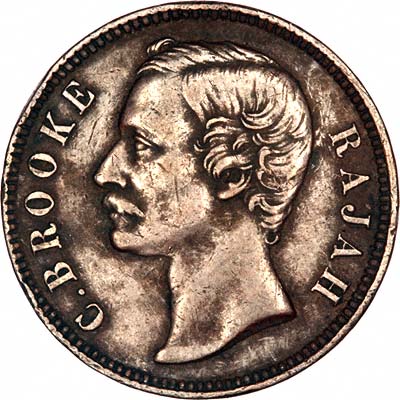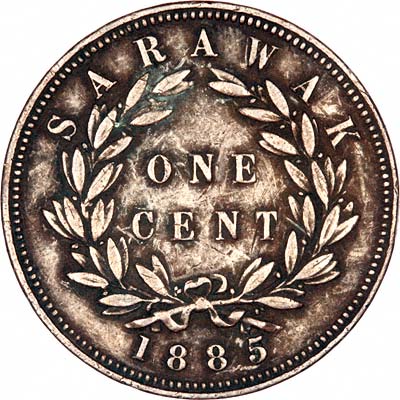| The Very Highest Quality Sarawak Coins... |
| Sarawak Coins |
|

|
|
|

|
Brief history of Sarawak
For the time being, we can probably do no better than quote Wkipedia:-
Sarawak is one of the two Malaysian states on the island of Borneo. Known as Bumi Kenyalang (‘Land of the Hornbills’), it is situated on the north-west of the island. It is the largest state in Malaysia; the second largest, Sabah, lies to the northeast.Coins of Sararak
The administrative capital is Kuching (pop. 600,300 in 2005) which literally means ‘cat’ (kucing). Major cities and towns also include Sibu (pop. 228,000), Miri (pop. 282,000) and Bintulu (pop. 152,761). As of last census (May 5, 2005), the state population was 2,376,800. It is interesting to note that Sarawak is, like Sabah to the north, a multicultural state, with no ethnic majority.
Sarawak had been a loosely governed territory under the control of the Brunei Sultanate in the early 19th century. James Brooke (see figure below) became governor of Sarawak on September 24, 1841 and was appointed Rajah by the Sultan of Brunei on August 18, 1842; originally this territory was just the western end of later Sarawak, around Kuching. He ruled Sarawak until his death in 1868. His nephew Charles Anthoni Johnson Brooke became Rajah after his death; he was succeeded on his death in 1917 by his son, Charles Vyner Brooke, with a provision that Charles should rule in consultation with his brother Bertram Brooke[1]. The territory was greatly expanded under these three, mostly at the expense of areas nominally under the control of Brunei. In practice Brunei had only controlled strategic river and coastal forts in much of the lost territory, and so most of the gain was at the expense of Muslim warlords and of the de facto independence of local tribes.
The Brooke dynasty ruled Sarawak for a hundred years and became famous as the "White Rajahs", accorded a status within the British Empire similar to that of the Indian Princes. In contrast to many other areas of the empire, however, the Brooke family was intent on a policy of paternalism to protect the indigenous population against exploitation. They governed with the aid of the Muslim Brunei Malay and Melanau people and employed the Ibans and other "Dayak" peoples as their army. They also encouraged the immigration of Chinese merchant class but forbade the Chinese to settle outside of towns in order to minimise the impact on the Dayak way of life. They also established the Sarawak Museum, the first museum in Borneo.
In the early part of 1941 preparations were afoot to introduce a new constitution, designed to limit the power of the Rajah and give the people of Sarawak a greater say in government.
While the intention was clearly admirable, the draft constitution contained defects and improprieties, not least by reason of a secret agreement drawn up between Charles Vyner Brooke and his top government officials, by which he was to be financially compensated for this gesture out of treasury funds.
and occupied the island of Borneo in 1941, occupying Miri on December 16 and Kuching on December 24, and held it for the duration of World War II until the area was secured by Australian forces in 1945. The Rajah formally ceded sovereignty to the British Crown on July 1, 1946, under pressure from his wife among others. In addition the British Government offered a healthy pension to sweeten the negotiations. His nephew Anthony continued to claim sovereignty as Rajah of Sarawak.
After the end of the Second World War, Anthony Brooke then opposed the cession of the Rajah's territory to the British Crown, and was associated with anti-cessionist groups in Sarawak. Anthony was banished from the country. He was allowed to return only seventeen years later, when Sarawak became part of the Federation of Malaysia.
Sarawak became a British colony (it was formerly an independent state under British protection) in July 1946, but Brooke's campaign continued. The Malays in particular resisted the cession to Britain, dramatically assassinating the first British governor. Sarawak was one of the main sites of the Indonesian Confrontation between 1962 and 1966. It became an autonomous state of the federation of Malaysia on September 16, 1963, despite initial opposition from parts of the population.
If you want to find the value of a coin you own, please take a look at our page I've Found An Old Coin, What's It Worth?
Coins Wanted
We make an active market in almost all world coins, gold or otherwise, including Sarawak coins. If you have any of these coins to sell, please contact us, or post them to us for appraisal and offer.
| ...at the Lowest Possible Price |
|
32 - 36 Harrowside, Blackpool, Lancashire, FY4 1RJ, England. Telephone (44) - (0) 1253 - 343081 ; Fax 408058; E-mail: The URL for our main page is: https://24carat.co.uk | Chard(1964) Ltd |